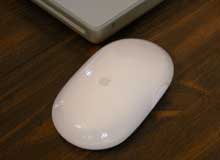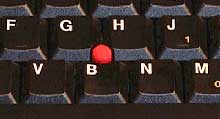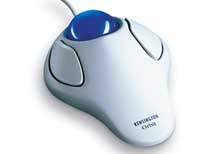WebQuest
Assured Model
Task

Input and Output Devices | Links to topics on this page: | ||
Before a computer can process your data, you need some method to input the data into the machine. The device you use will depend on what form this data takes (be it text, sound, artwork, etc.). Similarly, after the computer has processed your data, you often need to produce output of the results. This output could be a display on the computer screen, hardcopy on printed pages, or even the audio playback of music you composed on the computer. The terms “input” and “output” are used both as verbs to describe the process of entering or displaying the data, and as nouns referring to the data itself entered into or displayed by the computer. Below we discuss the variety of peripheral devices used for computer input and output. Input DevicesKeyboard | Input Devices | ||
The computer keyboard is used to enter text information into the computer, as when you type the contents of a report. The keyboard can also be used to type commands directing the computer to perform certain actions. Commands are typically chosen from an on-screen menu using a mouse, but there are often keyboard shortcuts for giving these same commands. In addition to the keys of the main keyboard (used for typing text), keyboards usually also have a numeric keypad (for entering numerical data efficiently), a bank of editing keys (used in text editing operations), and a row of function keys along the top (to easily invoke certain program functions). Laptop computers, which don’t have room for large keyboards, often include a “fn” key so that other keys can perform double duty (such as having a numeric keypad function embedded within the main keyboard keys). Improper use or positioning of a keyboard can lead to repetitive-stress injuries. Some ergonomic keyboards are designed with angled arrangements of keys and with built-in wrist rests that can minimize your risk of RSIs. Most keyboards attach to the PC via a PS/2 connector or USB port (newer). Older Macintosh computers used an ABD connector, but for several years now all Mac keyboards have connected using USB. Pointing DevicesThe graphical user interfaces (GUIs) in use today require some kind of device for positioning the on-screen cursor. Typical pointing devices are: mouse, trackball, touch pad, trackpoint, graphics tablet, joystick, and touch screen. Pointing devices, such as a mouse, connected to the PC via a serial ports (old), PS/2 mouse port (newer), or USB port (newest). Older Macs used ADB to connect their mice, but all recent Macs use USB (usually to a USB port right on the USB keyboard). Mouse |
PC Keyboard (you have one in front of you that you can see for a closer look) | ||
The mouse pointing device sits on your work surface and is moved with your hand. In older mice, a ball in the bottom of the mouse rolls on the surface as you move the mouse, and internal rollers sense the ball movement and transmit the information to the computer via the cord of the mouse. The newer optical mouse does not use a rolling ball, but instead uses a light and a small optical sensor to detect the motion of the mouse by tracking a tiny image of the desk surface. Optical mice avoid the problem of a dirty mouse ball, which causes regular mice to roll unsmoothly if the mouse ball and internal rollers are not cleaned frequently. A cordless or wireless mouse communicates with the computer via radio waves (often using BlueTooth hardware and protocol) so that a cord is not needed (but such mice need internal batteries). A mouse also includes one or more buttons (and possibly a scroll wheel) to allow users to interact with the GUI. The traditional PC mouse has two buttons, while the traditional Macintosh mouse has one button. On either type of computer you can also use mice with three or more buttons and a small scroll wheel (which can also usually be clicked like a button). Touch pad |
Two-button mouse with scroll wheel Wireless Macintosh mouse | ||
Most laptop computers today have a touch pad pointing device. You move the on-screen cursor by sliding your finger along the surface of the touch pad. The buttons are located below the pad, but most touch pads allow you to perform “mouse clicks” by tapping on the pad itself. Touch pads have the advantage over mice that they take up much less room to use. They have the advantage over trackballs (which were used on early laptops) that there are no moving parts to get dirty and result in jumpy cursor control. Trackpoint |
Touch pad of a PC laptop | ||
Some sub-notebook computers (such as the IBM ThinkPad), which lack room for even a touch pad, incorporate a trackpoint, a small rubber projection embedded between the keys of the keyboard. The trackpoint acts like a little joystick that can be used to control the position of the on-screen cursor. Trackball |
Trackpoint | ||
The trackball is sort of like an upside-down mouse, with the ball located on top. You use your fingers to roll the trackball, and internal rollers (similar to what’s inside a mouse) sense the motion which is transmitted to the computer. Trackballs have the advantage over mice in that the body of the trackball remains stationary on your desk, so you don’t need as much room to use the trackball. Early laptop computers often used trackballs (before superior touch pads came along). Trackballs have traditionally had the same problem as mice: dirty rollers can make their cursor control jumpy and unsmooth. But there are modern optical trackballs that don’t have this problem because their designs eliminate the rollers. Joysticks |
Trackball | ||
Joysticks and other game controllers can also be connected to a computer as pointing devices. They are generally used for playing games, and not for controlling the on-screen cursor in productivity software. Touch screenSome computers, especially small hand-held PDAs, have touch sensitive display screens. The user can make choices and press button images on the screen. You often use a stylus, which you hold like a pen, to “write” on the surface of a small touch screen. |
The Public URL for this WebQuest:
http://zunal.com/webquest.php?w=350001
WebQuest Hits: 844
Save WebQuest as PDF





